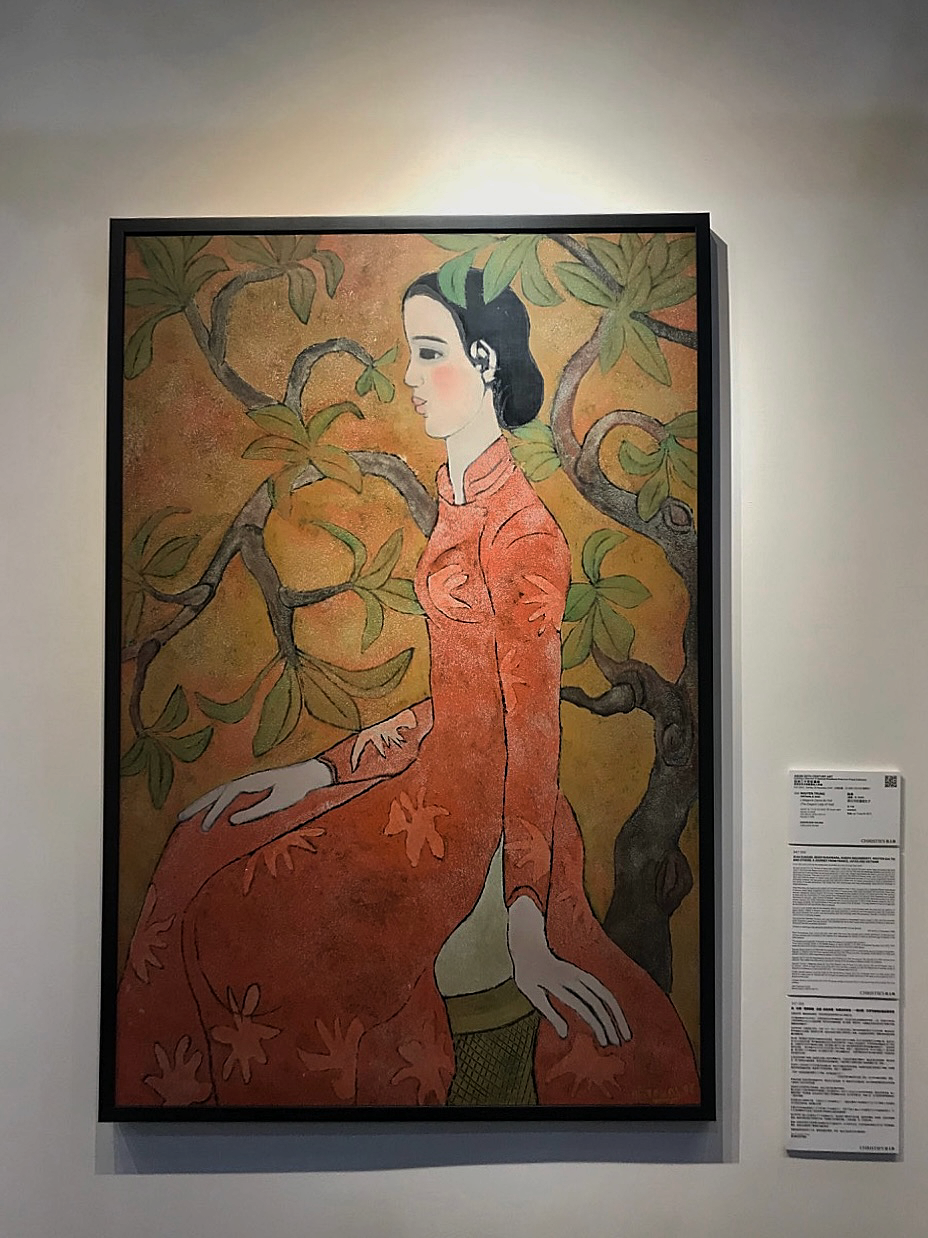
Nguyen Trung (Vietnam, B. 1940)
L'élégante Dame de Hué (The Elegant Lady of Hué)
signed 'ng. Trung' and dated '96' (lower right)
lacquer on panel
120 x 80 cm. (47 1/4 x 31 1/2 in.)
Painted in 1996
Provenance
Acquired directly from the artist
Collection of Boi Tran Garden, Hue, Vietnam
Christie's Hong Kong, 25 November 2018

Nguyen Trung's L'élégante Dame de Hué (The Elegant Lady of Hué)
Jean Dunand, Seizo Sugawara, Joseph Inguimberty, Nguyen Gia Tri and others: A Journey from France, Japan and Vietnam
In art, the truth is told by the artists and it is written as a fact, through their work.
As soon as the Fine Art School of Hanoi was created in 1924, they applied the exact same major principles that were used in the École des Beaux-Arts in Paris. It was only in time, little by little that the teachings adopted, specialized, and developed as it was enriched by the local sensitivity. In that way, Joseph Inguimberty decided to promote the art and technique of lacquer. This was an art form he knew well since the 1920’s in France, when Jean Dunand (1877–1942), who was firstly an expert in copper-ware, exhibited with a phenomenal success in Paris some magnificent lacquers (including screens). He had great success that seemed to follow him no matter everywhere in Paris or elsewhere, in any public or private exhibitions. The media then also contributed with their enthusiastic response and coverage of these exhibitions.
Félix Marcilhac, the best-known expert on Dunand, explains that in 1912, Dunand met a Japanese Master specialized in lacquer called Seizo Sugawara and who had lived in France since 1900. Both the artists will eventually share their secrets: metalwork versus lacquer techniques. Fascinated by this material (known in France since the 17th century at least with the importation of many pieces from China and Japan, Dunand will acquire from Sugawara an in-depth technique for lacquer. “Jean dreams of lacquer”, were the words found in Dunand’s wife personal journal, in an entry written January 3rd, 1919). Following a courageous war, Dunand presented in 1921 a large lacquer, using for the first-time bigger surfaces. He would impose in this way the modern form of lacquer - in a way where in it will no longer just be decorative but will specifically depict subjects.
Dunand could already see all the possible effects such a process could produce with the time and the addition of layers slowly. Indeed, in lacquer specifically the artist becomes a conductor as if the pigments were the musicians, the wood beneath the public, and the brushes and the humidity were the acoustics. Overall, a musical virtuoso ‘performance’ is skilfully created.
The encounter between Dunand, who was Swiss but became a naturalised French citizen in 1921, and the Japanese artist Sugawara, paved the way forward. This development led to the French artist Inguimberty bringing to the Hanoi School of Fine Art, an artistic revolution.
“If there is a technique that demands everything from the painter it is truly lacquer.” - Alix Ayme in L’Illustration, 1949
Rhus Succedanea, from which the resin was used, the wood, the climate and a whole generation of talented and virtuous painters will contribute in the creation of a Vietnamese Art School to reach an all-time high of talents in the 20th Century.
The exceptional ensemble of lacquers we have the pleasure to present here proves it:
Trinh Van’s Hunting Scene in the Middle Region of North Vietnam (Lot 354) synthetizes the style from 1935-1940 when the decorative screens imposes itself as the result of a long and subtle labour. Nguyen Sang’s Sumo (Lot 349) with this superb lacquer in a large format is undoubtedly paying homage to Sugawara.
Nguyen Tu Nghiem and his three classical themes Kim Van Kieu (Lot 347), Ong Than Gong (Lot 353), and Ancient Dance (Lot 348) magnificently appear on several levels.
Nguyen Gia Tri and his breathtaking Women and Children (Lot 351), his atypical The Farmers (Lot 352) and his more classical Two Ladies (Lot 350).
Nguyen Trung’s L'élégante Dame de Hué (The Elegant Lady of Hué) (Lot 356), favours the use of oil on canvas over lacquer - which is more time consuming and more complex, presents us with his depictions of women made of elegance and beauty in 2 lots presented here – one in lacquer and one in oil.
Finally, special mention must be made for the extraordinary Hoang Tich Chu landscape work (Lot 355), dated 1959 which is a high point of Vietnamese Art through its grace and subtle technique. This work is accompanied with a sketch by the artist
Lacquer shares a commonality with wine: the grape variety is important but it is the land of the local produce that truly matters.
Jean-François Hubert
Senior Expert, Vietnamese Art










